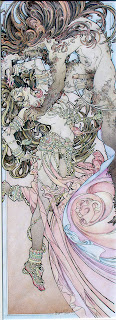
Both of my parents were avid readers and members of the San Fernando Library – that central hub of that little town – and my mother would bring home art books by the dozen which were my earliest education, so the images - even before I could tell the difference between photography and painting (art?) - were imprinted on my very psyche before almost anything else I can remember, in the same way we learn to eat or talk, instinctively.

 One work more deeply embedded than any of the others was Rubens’ Judgment of Paris – if only because the ladies were naked and, well… fat – those vast landscapes of flesh, those amazing accoutrements of symbol and drapery, and the general electrifying baroque energy of it all, bouncing off the old hand worn pages, some of which were actually inscribed with obscene graffiti by other readers no doubt moved by the almost palpable erotic energy to express in their own way
One work more deeply embedded than any of the others was Rubens’ Judgment of Paris – if only because the ladies were naked and, well… fat – those vast landscapes of flesh, those amazing accoutrements of symbol and drapery, and the general electrifying baroque energy of it all, bouncing off the old hand worn pages, some of which were actually inscribed with obscene graffiti by other readers no doubt moved by the almost palpable erotic energy to express in their own way  their own deep appreciation. Remember, this was long before pornography became anything as everyday as it is now, internet and cable weren’t even dreamed of, so this kind of picture would have been pretty much the only kind eroticism available out there, apart from blatant pornography – unfortunately, hypocritically, a distinction that is still unclear for most Trinis.
their own deep appreciation. Remember, this was long before pornography became anything as everyday as it is now, internet and cable weren’t even dreamed of, so this kind of picture would have been pretty much the only kind eroticism available out there, apart from blatant pornography – unfortunately, hypocritically, a distinction that is still unclear for most Trinis.
I’ve drawn The Judgment of Paris so many times I‘ve lost count. Something to do also, I think, with the business of beauty pageants (it must have been the very first recorded) – though in our case here, more specifically Carnival Queen Pageants; the business of threes (three goddesses); the business of deception (Aphrodite proffering Helen of Troy - the most beautiful woman in the world - as bribery for first place); the erotic current running through the  whole story (don’t tell me Paris wasn’t aroused, or that Hermes who organized the whole thing isn’t a walking phallus himself – I mean, think of the herms, his image - rampant erections all over the cities of Greece); the challenge of formalizing the whole thing in terms of composition and symbolism; and of course just plain good ole storytelling.
whole story (don’t tell me Paris wasn’t aroused, or that Hermes who organized the whole thing isn’t a walking phallus himself – I mean, think of the herms, his image - rampant erections all over the cities of Greece); the challenge of formalizing the whole thing in terms of composition and symbolism; and of course just plain good ole storytelling.
 So, here are a two of those images – one of the earliest, from around the very late 1980’s, from a series on the Iliad, and the latest, from as recently as last year. In the former, I differentiated and named the goddesses through their symbols – or I should say, my own personal symbols for them, hence (in the detail) the moon and water over Aphrodite’s head, since she was born of the sea – and the implication of the power of flight in the act of
So, here are a two of those images – one of the earliest, from around the very late 1980’s, from a series on the Iliad, and the latest, from as recently as last year. In the former, I differentiated and named the goddesses through their symbols – or I should say, my own personal symbols for them, hence (in the detail) the moon and water over Aphrodite’s head, since she was born of the sea – and the implication of the power of flight in the act of  hovering rather than the actual wings on Hermes headdress and sandals - though they’re certainly there in the most recent drawing - and of course his more rampant erotic embellishments. Hera I gave the symbol of vegetable fecundity for her fertility, and Athene a beating heart symbolizing passion and the spilling of blood in war. I wonder what, if anything, Rubens would think!
hovering rather than the actual wings on Hermes headdress and sandals - though they’re certainly there in the most recent drawing - and of course his more rampant erotic embellishments. Hera I gave the symbol of vegetable fecundity for her fertility, and Athene a beating heart symbolizing passion and the spilling of blood in war. I wonder what, if anything, Rubens would think!
 As I said in one of the earlier posts, things are interchangeable – I mean subjects and representations – with a few adjustments – a fascinating thing to know and finally understand and USE, which only gives credence to the observation about there being really only a handful of subjects and stories in the very first place – and that nothing is ever NEW – not ever!
As I said in one of the earlier posts, things are interchangeable – I mean subjects and representations – with a few adjustments – a fascinating thing to know and finally understand and USE, which only gives credence to the observation about there being really only a handful of subjects and stories in the very first place – and that nothing is ever NEW – not ever!














